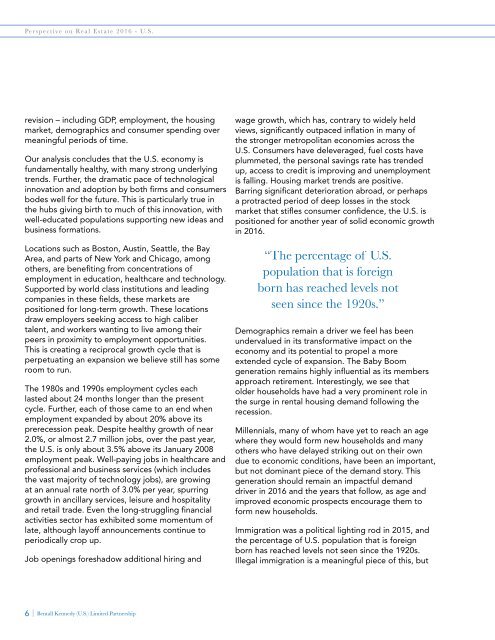BK Perspective Real Estate USA 2016
Create successful ePaper yourself
Turn your PDF publications into a flip-book with our unique Google optimized e-Paper software.
<strong>Perspective</strong> on <strong>Real</strong> <strong>Estate</strong> <strong>2016</strong> - U.S.<br />
revision – including GDP, employment, the housing<br />
market, demographics and consumer spending over<br />
meaningful periods of time.<br />
Our analysis concludes that the U.S. economy is<br />
fundamentally healthy, with many strong underlying<br />
trends. Further, the dramatic pace of technological<br />
innovation and adoption by both firms and consumers<br />
bodes well for the future. This is particularly true in<br />
the hubs giving birth to much of this innovation, with<br />
well-educated populations supporting new ideas and<br />
business formations.<br />
Locations such as Boston, Austin, Seattle, the Bay<br />
Area, and parts of New York and Chicago, among<br />
others, are benefiting from concentrations of<br />
employment in education, healthcare and technology.<br />
Supported by world class institutions and leading<br />
companies in these fields, these markets are<br />
positioned for long-term growth. These locations<br />
draw employers seeking access to high caliber<br />
talent, and workers wanting to live among their<br />
peers in proximity to employment opportunities.<br />
This is creating a reciprocal growth cycle that is<br />
perpetuating an expansion we believe still has some<br />
room to run.<br />
The 1980s and 1990s employment cycles each<br />
lasted about 24 months longer than the present<br />
cycle. Further, each of those came to an end when<br />
employment expanded by about 20% above its<br />
prerecession peak. Despite healthy growth of near<br />
2.0%, or almost 2.7 million jobs, over the past year,<br />
the U.S. is only about 3.5% above its January 2008<br />
employment peak. Well-paying jobs in healthcare and<br />
professional and business services (which includes<br />
the vast majority of technology jobs), are growing<br />
at an annual rate north of 3.0% per year, spurring<br />
growth in ancillary services, leisure and hospitality<br />
and retail trade. Even the long-struggling financial<br />
activities sector has exhibited some momentum of<br />
late, although layoff announcements continue to<br />
periodically crop up.<br />
Job openings foreshadow additional hiring and<br />
wage growth, which has, contrary to widely held<br />
views, significantly outpaced inflation in many of<br />
the stronger metropolitan economies across the<br />
U.S. Consumers have deleveraged, fuel costs have<br />
plummeted, the personal savings rate has trended<br />
up, access to credit is improving and unemployment<br />
is falling. Housing market trends are positive.<br />
Barring significant deterioration abroad, or perhaps<br />
a protracted period of deep losses in the stock<br />
market that stifles consumer confidence, the U.S. is<br />
positioned for another year of solid economic growth<br />
in <strong>2016</strong>.<br />
“The percentage of U.S.<br />
population that is foreign<br />
born has reached levels not<br />
seen since the 1920s.”<br />
Demographics remain a driver we feel has been<br />
undervalued in its transformative impact on the<br />
economy and its potential to propel a more<br />
extended cycle of expansion. The Baby Boom<br />
generation remains highly influential as its members<br />
approach retirement. Interestingly, we see that<br />
older households have had a very prominent role in<br />
the surge in rental housing demand following the<br />
recession.<br />
Millennials, many of whom have yet to reach an age<br />
where they would form new households and many<br />
others who have delayed striking out on their own<br />
due to economic conditions, have been an important,<br />
but not dominant piece of the demand story. This<br />
generation should remain an impactful demand<br />
driver in <strong>2016</strong> and the years that follow, as age and<br />
improved economic prospects encourage them to<br />
form new households.<br />
Immigration was a political lighting rod in 2015, and<br />
the percentage of U.S. population that is foreign<br />
born has reached levels not seen since the 1920s.<br />
Illegal immigration is a meaningful piece of this, but<br />
6 | Bentall Kennedy (U.S.) Limited Partnership


